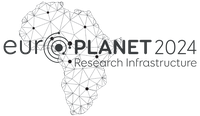Training School Program
The course provides both theoretical knowledge and practical skills in Earth Observation techniques and their adoption inside Geographical Information Systems (GIS). Students will acquire the fundamentals on the use of satellite remote sensing imagery to derive qualitative and quantitative information about the territory (at urban, basin and regional scale). Students will also develop practical skills through examples of EO data processing and thematic map generation. The main learning objective are: understanding of the main characteristics of multispectral satellite images; main EO satellite missions, with emphasis on Copernicus program; skills on basic pre-processing of images (radiometric and geometric); knowledge of the potential and limitations of image classification techniques; applications of EO.
13.12.2022
Day One
-
12:00 - 12:30
Registration-Earth Observation Techniques and data Analysis Europlanet WorkshopSeries.
-
12:30 - 12:50
Welcome-Earth Observation Techniques and data Analysis Workshop.
-
12:50 - 14:00
WELCOME LUNCH
-
14:00 - 15:30
Course Introduction. Geomatics and Remote Sensing. Digital images and their visualization.
Prof. G. Bitelli -
15:30 - 17:00
Basics of the theory of e.m. energy and multispectral imagery.
Prof. G. Bitelli
14.12.2022
Day Two
-
09:00 - 10:30
The 4 concepts of resolution in Earth Observation (Part I).
Prof. G. Bitelli -
10:30 - 10:50
Coffee Break
-
10:50 - 12:20
Short history of Remote Sensing, characteristics of satellite EO missions. Main missions and programs of Earth Observation (Part I).
Prof. G. Bitelli -
12:20 - 13:20
Lunch Break
-
13:20 - 13:40
Europlanet RI.
-
13:40 - 14:40
Main missions and programs of Earth Observation (Part II). The Copernicus program.
Prof. G. Bitelli -
14:40 - 15:40
Interaction of e.m energy with atmosphere and materials.
Prof. Bitelli -
15:40 - 16:30
Vegetation and other indexes derived from multispectral optical images. Pan Sharpening.
Dr. F. Trevisiol -
16:30 - 17:30
Radiometric and geometric correction. Pan Sharpening. SNAP (I): program interface.
Dr. F. Trevisiol
15.12.2022
Day Three
-
9:00 - 10:30
Classification of multispectral imagery. Methods and validation procedures.
Prof. G. Bitelli -
10:30 - 10:50
Coffee Break
-
10:50 - 13:00
SNAP (II): image manipulation and enhancement, image filtering, calculation of indexes.
Dr. F. Trevisiol -
13:00 - 13:50
Lunch Break
-
13:50 - 14:00
Network of Researchers on the Chemical Evolution of Life-NorCEL.
Dr. S. Jheeta, NoRCEL -
14:00 - 15:00
Change Detection studies. Review of EO applications.
Dr. F. Trevisiol -
15:00 - 16:00
SNAP (III): pre-processing operations, multispectral image classification (Part I).
Dr. F. Trevisiol -
16.00 - 17.00
SNAP (IV): multispectral image classification (Part II), validation of the results.
Dr. F. Trevisiol
16.12.2022
Friday
Day Four
-
09:00 - 10:00
Radar imagery: basics of SAR applications.
Dr. F. Trevisiol -
10:00 - 10:20
Cofee break
-
10:20 - 10:50
Urban heat islands and heat waves in tropical cities in the Greater Horn Africa
Dr. Gemechu Fanta Garuma -
10:50 - 11:40
ASI programmatic activities and Earth Observation satellite applications
Dr. P. Sacco -
11:40 - 12:20
Relationship Between Precipitation Extremes and Convective Organization Inferred From Satellite Observations
Dr. Addisu Gezahegn -
12:20 - 13:00
WOMEN AND SCIENCE, 100 YEARS AFTER THE BIRTH OF MARGHERITA HACK
-
13:00 - 13:40
Inauguration and visit of the exhibition "LOOKING BEYOND/Guardare oltre" by Filippo Maggia
Dr. Semen Kumurzhi , Prof. Barbara Cavalazzi -
13:40 - 14:40
lunch
